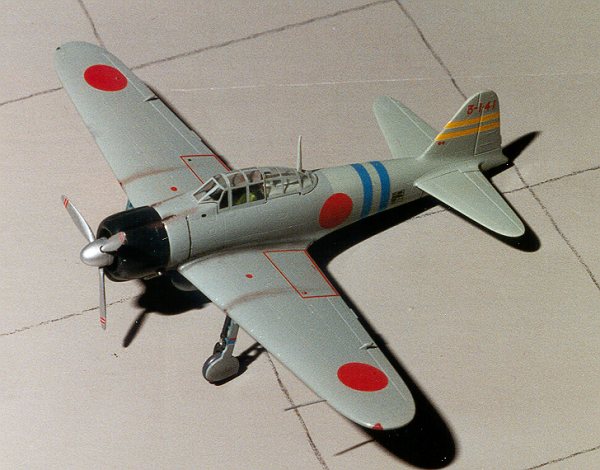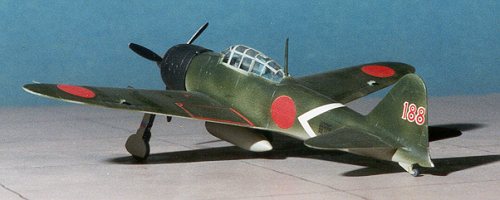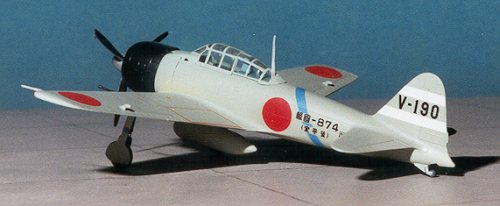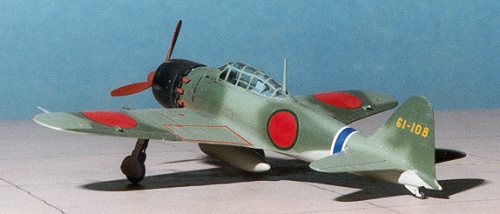
|
KIT: |
Hasegawa 1/72 A6M Zero series |
|
KIT # |
AP 14, 15, 16, 22 |
|
PRICE: |
$24.25 |
|
DECALS: |
See review |
|
REVIEW
& |
|
|
NOTES: |
|
|
HISTORY |

The A6M Zero-sen is undoubtedly the one aircraft that the general public can name concerning Japanese aircraft of WWII (assuming they know what WWII was!). First developed in 1940, the aircraft was built on the premise that lightness and maneuverability was paramount. The result was an aircraft that was superbly aerobatic and had astonishing range. This was all done at the sacrifice of any kind of armor protection for the pilot or fuel systems. The end result of this was that when the Zero was hit, it generally went down. Only later in the war was an increase in armor protection added. As you might expect, the handling of the aircraft suffered from the additional weight.
Unlike US aero engine makers, most Japanese engines, like their German counterparts, did not generate the kind of horsepower that were found in the Hellcats and Corsairs. The result was a need to keep weight down in order to provide the required performance. Those large horsepower Japanese engines that were developed later in the war were notoriously unreliable. Adding extra equipment or armor plating had adverse affects on the performance of the aircraft.

The initial A6M2 type 11 was first encountered over China and despite having reports sent back on the aircraft, US general officers disbelieved them. It was quite a shock to find that they were true as the Zeros cut to pieces the defending American air power. The Zero was modified into several different variants over the course of the war. The only real change (other than engines of a bit greater power) came with the last mass produced version, the A6M5. This one had a wing of larger chord to try to get back some of the maneuverability lost by adding armor plating.
As you may have read in other places, the majority of Zeros were not built by Mitsubishi, but by Nakajima. In the end, over 10,000 were produced. No where near the numbers of other aircraft like the Bf-109, Spitfire or Mustang.
Today there are a number of Zeros in museums and one original Zero is kept in flying condition by Planes of Fame in Chino, CA. Having seen it fly on a number of occasions, I can tell you that it is quite a sight!
|
THE KIT & CONSTRUCTION |

Hasegawa's more recent molds for the 1/72 A6M are really superb. And they should be as they command prices three times that of the older kit. All of them have engraved panel lines, nice engines, a well detailed cockpit (for the scale) and are of a modular design. The cockpits have decals for the instrument panel. The canopies are all one piece, so you cannot display any work done in the interior with the kit canopy. As I mentioned, the kits are a modular design so that you can use common items with all the different boxings of this kit. As of this writing, there are at least a dozen of them.
It has been theorized that the aircraft most produced in model kit form is the A6M Zero and I can easily believe that. It has also been said that only 20% of those kits produced by Japan are exported, the rest being sold at home. If that is true, then most Japanese males must be model builders as there sure is are a lot of Japanese kits on store shelves and in model contests.

It is difficult to find any area where these kits are a problem. While they are not perfect, they are almost totally devoid of any areas that need work. I said almost. On every one of the kits I built, I had to be especially careful of the upper forward fuselage insert. It seems this part is not a perfect fit and does need some work with filler. The rest of the kit is really a breeze.
Let me give you a bit of info on each one of the four that I built. These kits were constructed over a seven month period in 1995. This was before I was aware of several things regarding Japanese camouflage and colors that I now know. The result is a rather odd mixture of paints and practices. We were all innocent of things like this at one time and they are only really evident if one has previous knowledge of the subject. To all JNAF camo experts, I give my apologies, but there it is!
|
CAMO SCHEMES |
 The first kit in the series is an A6M2 type 11. This was the first
major production aircraft, and all were built by Mitsubishi. While I forget the
pilot of this plane, (as I have with all the others), I do know that it is
painted in a two tone grey, with the forward section being a darker color. This
scheme is clearly shown in the cover photo of the reference. I really hadn't
paid much attention to it until the instruction sheet showed this as a normal
scheme. The more that I read about JNAF paint schemes, the more it seems
that the light grey color should be much darker than most of us have been
painting our early war aircraft, especially on the A6M.
The first kit in the series is an A6M2 type 11. This was the first
major production aircraft, and all were built by Mitsubishi. While I forget the
pilot of this plane, (as I have with all the others), I do know that it is
painted in a two tone grey, with the forward section being a darker color. This
scheme is clearly shown in the cover photo of the reference. I really hadn't
paid much attention to it until the instruction sheet showed this as a normal
scheme. The more that I read about JNAF paint schemes, the more it seems
that the light grey color should be much darker than most of us have been
painting our early war aircraft, especially on the A6M.
Most all early war Zeros were in the overall grey color. The cowlings were painted black. This color rapidly oxidized in the salt air and sun to a blueish black color. Not all type 11s had radios in them as Japanese radios were quite poor. The pilots also didn't want the extra weight. Props were all silver or natural metal with black backsides. I screwed up big time on this and all my previous WW2 Japanese aircraft kits by painting the interiors with the Aotake color. They should be a darkish green.
 The
next kit in this series is the A6M3 type 22. This series can be distinguished
from the earlier types by a redesigned cowling. Gone is the undercowl oil cooler
intake. This was incorporated into the upper lip of the cowling itself. The type
22 also had long gun barrels for the wing 20mm cannon.
The
next kit in this series is the A6M3 type 22. This series can be distinguished
from the earlier types by a redesigned cowling. Gone is the undercowl oil cooler
intake. This was incorporated into the upper lip of the cowling itself. The type
22 also had long gun barrels for the wing 20mm cannon.
Most of these aircraft were delivered in the overall grey color, however, by this time, a number of units were land based. When this happened, it was normal for the tail hook to be removed and a plate put in its place. It was also not unusual for the aircraft to have a coat of paint applied over the previous overall grey scheme. Often this was done in the field and it resulted in a rather 'tatty' appearance. This was true of the older A6M2 aircraft that were still in service and flying from land bases. In 1943, a requirement was made for a yellow IFF stripe to be painted along the leading edge of the wing. This stripe was in colors from a pale yellow to an orange-yellow. While the length and breadth of the stripe was supposed to be standard, you'll find quite a variance in practice. Again, those older Zeros still in service had this added to them. A6M3 aircraft were delivered with a propeller painted just like those of the earlier A6M2 versions; silver with black backsides.
 It was discovered that there was a need to improve
the roll rate of the aircraft. As a result, a clipped wing version of the A6M3,
the type 32, was developed. Basically, the folding wing tips were removed and a
permanent, squared off tip was put in its place. I do believe that all of the
type 32s were land based so were not equipped with tail hooks.
It was discovered that there was a need to improve
the roll rate of the aircraft. As a result, a clipped wing version of the A6M3,
the type 32, was developed. Basically, the folding wing tips were removed and a
permanent, squared off tip was put in its place. I do believe that all of the
type 32s were land based so were not equipped with tail hooks.
These were not built in large numbers and all were delivered in overall grey, though, like other aircraft, they were often camouflaged at the local level. An interesting item on this particular kit is the presentation number, this one being aircraft #874.
It was not uncommon for aircraft to be paid for by patriotic individuals or groups. This happened in all of the world's military forces during this time. The Japanese were the most methodical about it, assigning a number to each presentation aircraft. Under the number would be "From the workers of Showa Heavy Industries" or something like that. It was not uncommon for wealthy persons to provide enough funds to build several aircraft.
 The final production version of the
Zero was the A6M5. Most of these were built by Nakajima and not Mitsubishi. This
version introduced a major wing modification. In order to hold the increased
number of guns in the wings and to get back some of the lost maneuverability,
the wing was made of a much larger chord. It was also shorter than the earlier
wings and had no need of wing tip folding. The A6M5 was also built in larger
numbers than all the others combined. There were various subtypes of the A6M5,
but all looked basically the same.
The final production version of the
Zero was the A6M5. Most of these were built by Nakajima and not Mitsubishi. This
version introduced a major wing modification. In order to hold the increased
number of guns in the wings and to get back some of the lost maneuverability,
the wing was made of a much larger chord. It was also shorter than the earlier
wings and had no need of wing tip folding. The A6M5 was also built in larger
numbers than all the others combined. There were various subtypes of the A6M5,
but all looked basically the same.
By this time, all aircraft were camouflaged at the factory and had the dark brown propellers common in the later war years. For this kit I used Model Master rust, which is really too light and too reddish. The A6M5 also introduced individual ejector exhausts for a bit of extra power. The camo scheme on this one is shown as two shades of green. This 'cloud' pattern is based on a photograph of one being brought back to the US after the war. Some think that the light green parts of this scheme should be natural metal instead. This would also make the underside natural metal instead of light grey! The feeling is that by this time in the war, it was more important to get the aircraft to the unit and not waste time painting all of it. Only the areas around the Hinomaru were painted. The fuselage insignia also had the white surround painted over with dark green. It may not be correct, but it looks neat!
So there you have it. Four super kits. If you have any interest in the subject and can handle the price of the kits, pick up a bunch of them. They are great builds and recommended for all levels of modeling skill.
|
REFERENCES |
Japanese Aircraft of the Pacific War by Rene J Francillon, Putnam, 1979
Review copy courtesy of me and my wallet!
If you would like your product reviewed fairly and quickly by a site that has over 1,100 visits a day, please contact me or see other details in the Note to Contributors.